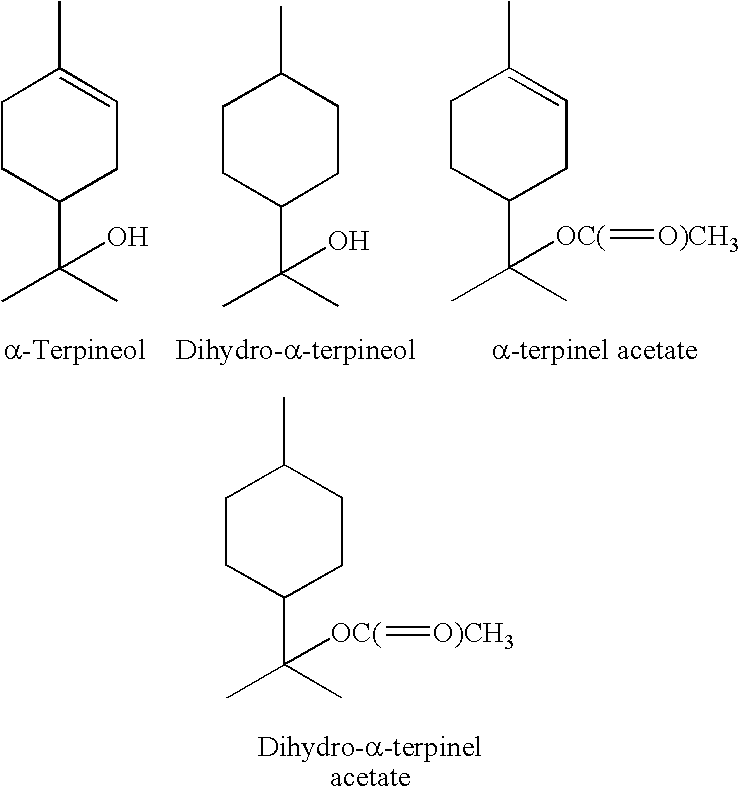Microencapsulated Pesticide
a pesticide and micro-encapsulation technology, applied in the field of micro-encapsulation of pesticidal compounds, can solve the problems of difficult to make the pesticidal compound enclosed sufficiently, and achieve the effects of low viscosity, easy dispersion in water, and high solubility in water
- Summary
- Abstract
- Description
- Claims
- Application Information
AI Technical Summary
Benefits of technology
Problems solved by technology
Method used
Image
Examples
production example 1
[0048]Two hundred grams of procymidone and 800 g of dihydroterpinel acetate (produced by Yasuhara Chemical Co., Ltd., content: 99.6%) were mixed, and the mixture was roughly pulverized for about 10 minutes using a high-speed shear stirrer (POLYTRON, manufactured by KINEMATICA AG). The resulting mixture was further subjected to wet-pulverization at a feeding rate of 3 L / hr and a peripheral speed of 10 m / sec using a DYNO-MILL (having a vessel size of 600 mL, manufactured by WILLY A. BACHOFEN AG. MASHINENFABRIK) filled with 1120 g of beads (1.25 mm zirconia). The procymidone particles after the wet pulverization had a volume median diameter of 2.2 μm. The procymidone particles were suspended almost uniformly in dihydroterpinel acetate and almost no flocculation was recognized. The suspension in the wet-pulverization had a viscosity of 2010 mPa·s (Brookfield viscometer, rotor No. 3, 6 rpm).
[0049]A mixture obtained by addition of 2.42 g of a polyisocyanate (Sumijule L-75, produced by Sum...
production example 2
[0051]Two hundred grams of nitempyram and 800 g of dihydroterpinel acetate (produced by Yasuhara Chemical Co., Ltd., content: 99.6%) were mixed, and the mixture was roughly pulverized for about 10 minutes using a high-speed shear stirrer (POLYTRON, manufactured by KINEMATICA AG). The resulting mixture was further subjected to wet-pulverization at a feeding rate of 3 L / hr and a peripheral speed of 10 m / sec using a DYNO-MILL (having a vessel size of 600 mL, manufactured by WILLY A. BACHOFEN AG. MASHINENFABRIK) filled with 1120 g of beads (1.25 mm zirconia). The suspension in the wet-pulverization had a viscosity of 2150 mPa·s (Brookfield viscometer, rotor No. 3, 6 rpm).
[0052]A mixture obtained by addition of 2.42 g of a polyisocyanate (Sumijule L-75, produced by Sumika Bayer Urethane Co., Ltd.) to 25 g of the resulting suspension was added to 39.2 g of deionized water in which 1.4 g of ethylene glycol and 3.29 g of gum arabic (Arabic Cole SS, produced by San-ei Yakuhin Boeki Co., Ltd....
production example 3
[0054]Two hundred grams of clothianidin and 800 g of dihydroterpinel acetate (produced by Yasuhara Chemical Co., Ltd., content: 99.6%) were mixed, and the mixture was roughly pulverized for about 10 minutes using a high-speed shear stirrer (POLYTRON, manufactured by KINEMATICA AG). The resulting mixture was further subjected to wet-pulverization at a feeding rate of 3 L / hr and a peripheral speed of 10 m / sec using a DYNO-MILL (having a vessel size of 600 mL, manufactured by WILLY A. BACHOFEN AG. MASHINENFABRIK) filled with 1120 g of beads (1.25 mm zirconia). The clothianidin particles after the wet pulverization had a volume median diameter of 2.6 μm. The clothianidin particles were suspended almost uniformly in dihydroterpinel acetate and almost no flocculation was recognized. The suspension in the wet-pulverization had a viscosity of 1400 mPa·s (Brookfield viscometer, rotor No. 2, 6 rpm, 25° C.).
[0055]A mixture obtained by addition of 2.42 g of a polyisocyanate (Sumijule L-75, prod...
PUM
| Property | Measurement | Unit |
|---|---|---|
| Diameter | aaaaa | aaaaa |
Abstract
Description
Claims
Application Information
 Login to View More
Login to View More - R&D
- Intellectual Property
- Life Sciences
- Materials
- Tech Scout
- Unparalleled Data Quality
- Higher Quality Content
- 60% Fewer Hallucinations
Browse by: Latest US Patents, China's latest patents, Technical Efficacy Thesaurus, Application Domain, Technology Topic, Popular Technical Reports.
© 2025 PatSnap. All rights reserved.Legal|Privacy policy|Modern Slavery Act Transparency Statement|Sitemap|About US| Contact US: help@patsnap.com

